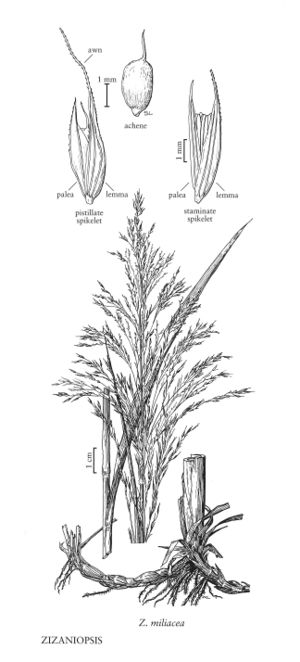| Taxon | Illustrator ⠉ | |
|---|---|---|
 | Zizaniopsis miliacea | Sandy Long |
Plants perennial or annual; aquatic, rooted and emergent; rhizomatous; monoecious. Culms 1-4 m, erect or decumbent, sometimes rooting at the nodes. Leaves basal and cauline; sheaths open, somewhat laterally compressed; ligules scarious; pseudopetioles absent; blades flat or folded at the base, lanceolate. Inflorescences terminal panicles, staminate and pistillate spikelets on the same branches, staminate spikelets proximal, pistillate spikelets distal; disarticulation beneath the spikelets; pedicel apices cupulate. Spikelets unisexual, laterally compressed to subterete, lemma margins not clasping the paleas, with 1 floret. Glumes absent; calluses glabrous. Staminate lemmas membranous, 5-7-veined, acuminate or terminally awned; paleas similar to the lemmas, 3-veined; lodicules 2; anthers 6. Pistillate lemmas membranous, 7-veined, terminally awned; paleas similar to the lemmas, 3-veined, awned or unawned; styles 2, bases fused, stigmas terminally exserted, plumose. Fruits achenes, ellipsoid or obovoid, beaked by the persistent style base; pericarps shell-like, partially free from the seed, smooth, coriaceous or crustaceous; seeds oblong, subterete, or 2-angled; embryos basal; hila linear, x = 12.
Distribution
Md., Okla., Miss., Tex., La., Mo., Ala., Tenn., N.C., S.C., Va., Ark., Ill., Ga., Ky., Fla.
Discussion
Zizaniopsis grows from the southern United States to Argentina. All of its five species grow in wet habitats. Only Zizaniopsis miliacea is native to and found in the Flora region.
Selected References
Lower Taxa
"decumbent" is not a number.